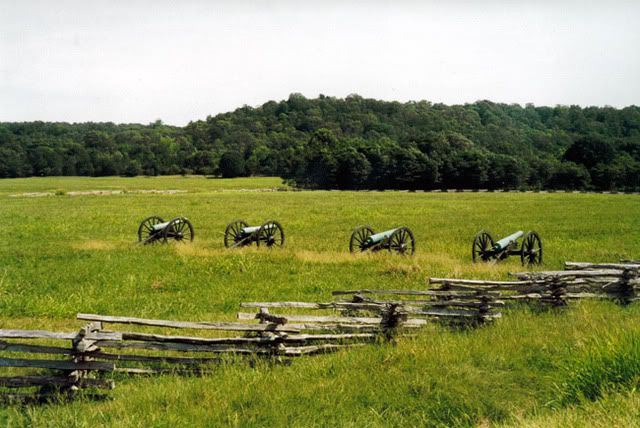Pea Ridge National Military Park
The most celebrated event in American history is the Civil War. Each year, thousands of people dress up in period costumes and reenact popular battles. The American landscape is littered with state parks, national parks, and historic markers celebrating the Civil War. This war not only divided the Americans, but also the Indians, particularly those living in Oklahoma. Many of the tribes, such as the Cherokee and the Creek, were divided between their loyalties to a slave-owning confederacy and to the federal government.
One of the early battles in the Civil War which involved Indians occurred in Arkansas in 1862 at a place known as Pea Ridge. Nearly a century later, in 1956, the Arkansas congressional delegation proposed legislation to make this battlefield a national military park. Congress responded by passing the act which created the Pea Ridge National Military Park.


The Pea Ridge National Military Park is shown above.

The Confederate monument at Pea Ridge is shown above. Long before the Pea Ridge battlefield was declared a national monument, many Union and Confederate veterans attended reunions at the site. The first of these was held in 1887, some 25 years after the battle. The veterans dedicated monuments on the battlefield to both the Union and Confederate dead.
The Cherokee at Pea Ridge:
Prior to the Civil War, the Cherokee in Oklahoma were a deeply divided nation. The Civil War exacerbated this division: John Ross, a slave owner and principal chief, supported the Union and spent the war attempting to lead a government in exile; Stand Watie, a southern sympathizer, replaced Ross as principal chief and led Cherokee troops for the Confederacy. Stand Watie, who held the rank of Colonel in the Confederate Army, formed the 2nd Cherokee Mounted Rifles and commanded this regiment at Pea Ridge.
At the Battle of Pea Ridge almost 1,000 Cherokee made up two Confederate regiments. These Indian regiments were a part of the division commanded by General McCulloch.
In spite of the fact that the Union forces were outnumbered and outgunned by the Confederates, the Battle of Pea Ridge was a decisive victory for the Federal Army.
After the battle, Watie commanded a brigade of Native American troops. He led his troops in 18 battles and major skirmishes. In 1864, he was promoted to the rank of Brigadier General. When he surrendered to Federal troops in June 1865 he was the last Confederate general to surrender.

General Stand Watie is shown above.

Shown above are Cherokee Confederates at a 1903 reunion.
Trail of Tears:
The Pea Ridge National Military Monument is also a part of the Cherokee Trail of Tears. A portion of the pre-war Old Telegraph/Wire Road in the Monument includes 2.5 miles of the Trail of Tears.
In 1838, the United States Army rounded up the Cherokee in Tennessee, Georgia, North Carolina, and Alabama and then force-marched them 1,500 miles to Oklahoma. The Trail of Tears – called Nunna daul Isunyi in Cherokee which means “trail where we cried” – resulted in the death of an estimated 8,000 Cherokees. The Cherokees were forced to abandon their property and their unharvested crops. Mounted soldiers, using their bayonets as prods, herded the Cherokee like cattle.
The Cherokee were removed in 13 different groups which traveled by different routes.



